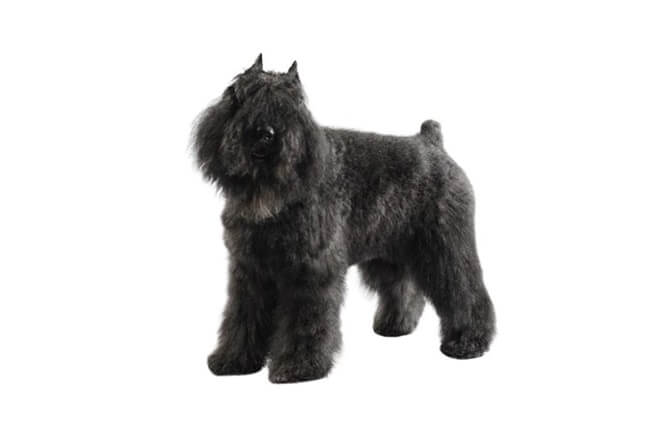
The sturdy, rugged Bouvier des Flandres originally was bred to herd cattle near the Belgian town of Flanders. His name means “cowherd from Flanders,” but along with herding, the breed performed farm jobs such as drafting and guarding. With his calm, gentle temperament, this breed is a loving family companion. The Bouvier needs frequent grooming to strip his rough, shaggy coat and plenty of exercise.
DID YOU KNOW? The slow-maturing Bouvier des Flandres reaches adulthood at 2 to 3 years of age. During World War I, the Bouvier served as message carriers and cart dogs carrying wounded soldiers.
ALSO KNOWN AS: Flanders Cattle Dog, Vlaamse Koehond
The need-to-know
- Dog suitable for experienced owners
- Extra training required
- Enjoys vigorous walks
- Enjoys walking more than two hours a day
- Large dog
- Some drool
- Requires grooming every other day
- Non hypoallergenic breed
- Quiet dog
- Guard dog. Barks, alerts and it's physically protective
- May require training to live with other pets
- May require training to live with kids
Personality

The Bouvier can appear forbidding, serious and unamused, but to their friends and family they have an unflappable, amiable nature, and are affectionate and loving. With strangers they are inclined to be reserved and suspicious but should never be aggressive. Calm and sensible as adults, the Bouvier has the temperament and trainability to perform a variety of tasks and they have been used as police dogs and guide dogs as well as their original farm dog duties.
History and Origins

Country of Origin: Belgium
The Bouvier des Flandres has a rather uncertain history, as many working types do, being selected and bred for working ability rather than appearance. Belgium and France had a number of similar working breeds including the Bouvier des Ardennes, the Bouvier de Roulers and the Bouvier des Flandres, however these were very much types rather than recognisable breeds with any kind of written breed standard. It is thought that the Bouvier de Flandres was developed from Barbets, Brabanters, Schnauzers, Griffons and Beaucerons, although it is likely other breeds were involved too.
Nutrition and Feeding

Large breed dogs, as well as having large appetites, benefit from a different balance of nutrients including minerals and vitamins compared to smaller-breed dogs. The Bouvier is prone to bloating and stomach problems; smaller, more frequent meals can help minimise this risk.
Exercise

As puppies, exercise should be carefully controlled, as this is going to be a relatively heavy adult. Once fully grown the Bouvier will require two hours minimum of daily walking and running exercise, with training, puzzle solving and games on top. Used to working all day, the Bouvier who does not get sufficient mental and physical exercise will be unhappy, and certainly won’t be a joy to live with either!
Other Information

Health and common issues
Bouvier des Flandres are relatively hardy dogs, but as with many breeds, they can suffer from various hereditary eye disorders, and hip dysplasia (a condition that can lead to mobility problems). Eye testing and hip scoring of dogs prior to breeding is therefore important. The breed is particularly predisposed to laryngeal paralysis, which can result in noisy breathing and difficulty breathing. The breed club monitor the health of the breed carefully and should be contacted for the most up-to-date information and details of any DNA or additional testing they recommend. Breed Clubs can be found on the Kennel Club website.
Space requirements
As a big dog with a protective nature, this is a breed better suited to a larger home and rural or suburban location as they are likely to find busy, urban environments over stimulating and stressful. Whilst the Bouvier does not shed, they need frequent grooming to prevent matting and this will take time and space. A secure garden is vital, as is access to a variety of safe walking routes and secure spaces for off lead fun.
Training bouvier des flandres
The Bouvier des Flandres is a very trainable dog, as long as you take the time to build a bond with them and be kind, fair and consistent. They have worked as cattle and sheep herders, pulled carts, guided the blind and assisted police, so its fair to say they are a versatile and intelligent breed. This is a dog who will enjoy some form of training most days, as an activity in its own right rather than just a means to an end, and they won’t appreciate being left alone or separated from their family for long. Easily capable of a variety of dog sports though possibly a little large and heavy to really excel in some, the Bouvier could be a fun companion for someone who wants to have a go at a selection of canine activities. Work hard on early socialisation to other animals and children, and install a solid recall as the Bouvier may take some persuasion to return and stop herding up stray people!
Best family dog breeds
For the family with time and space, the Bouvier can make an excellent companion, however keep in mind the grooming requirements are high and a full brush through can take an hour every other day. Like many herding/droving breeds, the Bouvier can be distressed by members of their social group splitting up. With smaller children the temptation to round them up and keep them together may be too strong to resist. Small children generally don’t enjoy being rounded up so this may be a dog for the family with older children or teenagers. While many dogs are traditionally thought of as being good with children, all dogs and children need to be taught to get on with and respect each other, and be safe together. Even so, dogs and young children should never be left alone together and adults should supervise all interactions between them.
Did you know?